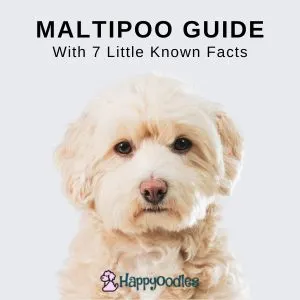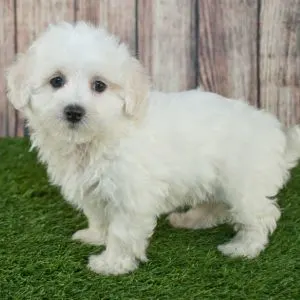Updated 01/09/2024 – If you are interested in learning about the charming and cuddly Maltipoo, you have come to the right place. Here we will cover everything you need to know about the Maltipoo, including some little-known facts in 2024 that other guides don’t tell you.
Plus, since the world of Maltipoo dogs is constantly changing, we will share with you the latest information we have about them.
If you are interested in learning about the charming and cuddly Maltipoo, you have come to the right place. Here we will cover everything you need to know about the Maltese Poodle Crossbreed, including some little-known facts that other guides don’t tell you.
Plus, since the world of Maltipoo dogs is constantly changing, we will share with you the latest information we have about them.
In this post we will cover:
- Breeding
- Size range
- Lifespan
- Health concerns
- Temperament
- Train-ability
- Exercise
- Appearance
- Maintenance
- Where to look for one
- Frequently asked questions
- Little Known Facts about the Maltepoo

Whether you’re a first-time dog owner or a seasoned pet enthusiast, this guide will provide you with invaluable insights into the Maltipoo’s unique characteristics, care requirements, training tips, and much more. But, before we get started let’s look at some Quick Facts about the Maltiepoo.
Quick Facts about the Maltipoo
| Breeding | Crossbreed of a Poodle and Maltese |
| Weight Range | 4 to 25 pounds |
| Lifespan | 12 to 16 years |
| Temperament | Affectionate, Playful, Outgoing, Intelligent |
| Shedding | Low Shed, but high maintenance |
| Trainability | Highly intelligent dogs that are easy to train |

Maltipoo Overview
The Malti-poo is a hybrid dog breed that’s a cross between a Maltese and a Poodle. Usually a Toy or Miniature Poodle is used. They’re known for their adorable teddy bear appearance and their friendly and outgoing personality.
Malti-poos are often bred to combine the best traits of both parent breeds, such as the Maltese’s friendly nature and the Poodle’s intelligence. Since both the poodle and Maltese are low shed dogs you can expect the Malti-poo to shed minimally.
Breeding
By this point you know that a Maltipoo is a crossbreed between a poodle and a Malti-poo. But there is more to the Malt-ipoo’s breeding than that. Malti-poos also come in different generations and sizes.
When looking for a Malti-poo puppy you will find ones that are a first generation cross between the Maltese and Poodle or you can look for a later generation like the F1B Malti-poo. Which generation you choose will affect the Malti-poos appearance, personality and even their size.
In this next section we will explain what each doodle generation code (F1, F2b, F2 etc.) means and how it can affect what your Malti-poo may be like.

What is a Doodle Generation Code?
The doodle generation code gives a potential buyer an idea of how the doodle was bred and what percentage of poodle vs Maltese the dog is.
F1 – A puppy that is labeled F1 is a first time cross of a Poodle and Maltese. This means the puppy is 50% poodle and 50% Maltese. In these cases, the puppy can inherit any of the poodles or Maltese’s traits or fur type. Most of the time they end up with a combination of the two.
F1b – When you mate a F1 Malti-poo with a poodle you get an F1B Malti-poo. This would give you a dog that is approximately 75% poodle and 25% Maltese. But remember that this is just an estimate.
Since the F1b will be more poodle than Maltese, they may have curlier fur, or take on more of the poodle’s personality. The size of the poodle will also impact the size of the Malti-poo. Using a mini poodle, which is bigger than the Maltese, for both the first- and second-generation breeding will result in a larger Malti-poo
In some cases, a F1B poo can also be 25% poodle and 75% Maltese if the breeder used a Maltese for the cross-back instead of a poodle. This is done sometimes if the F1 Malti-poo inherited too many of the poodle’s traits, like very curly fur or a hyper personality.
F2 – a F2 doodle is a second-generation doodle. F2 Malti-poos are less common than the F1 or F2b. The F2 is a result of two F1 doodles being mated.
F2 doodles are the least predictable, since you will not know which traits will be passed down to the off-spring. This generation can end up favoring one breed over the other.

Size
Maltese Poodle mix breeds can vary in size, and this is often determined by the size of the Poodle parent used in breeding and the generation. Generally, there are three main size categories:
- Teacup or Tiny Toy Maltepoos: These are the smallest and can weigh around 4 to 6 pounds or even less. Their height is generally less than 7 inches. They are very delicate and need extra care due to their tiny size.
- Toy Maltepoos: Toy Malti-poos usually weigh between 6 to 10 pounds and are less than 12 inches tall. They are still quite small but slightly larger than teacup Malti-poos.
- Miniature Maltepoos: Miniature Malti-poos are the largest in this breed and can weigh anywhere from 10 to 25 pounds and grow to 15 inches tall. They’re still small dogs, but they have a bit more substance.

Lifespan
Maltipoos generally have a lifespan of around 10 to 16 years, depending on genetics, care, and overall health. Providing them with proper medical care, a balanced diet, regular exercise, and a safe environment can contribute to a longer, healthier life.
Health Concerns
Like all dog breeds, Maltepoos can have their share of health concerns, many of which are linked to their parent breeds. Some common issues include dental problems, allergies, joint issues, and eye conditions. Regular veterinary check-ups, a balanced diet, and proper grooming can help mitigate potential health problems.

Some health conditions to look out for include:
- Dental Issues
Small dog breeds like Maltepoos are prone to dental problems such as gum disease, tartar buildup, and tooth decay. Regular dental care, including brushing their teeth and providing dental chews, can help maintain their oral health.
- Luxating Patella
Maltepoos may inherit this condition from their parent breeds, which involves the kneecap slipping out of its normal position. This can lead to discomfort and lameness.
- Epilepsy
Epilepsy is a predisposed neurological condition that can be found in Maltipoos. You should watch your pup for signs of seizures, including: Collapse, becoming stiff, paddling the limbs, and suddenly urinating or defecating. According to PetMD for some Maltepoos, an epileptic seizure might only happen once or twice in their lifetime, or it can be a recurring issue for others. Most dogs with epilepsy can live a normal life with medication.
- Allergies
Maltese Poodle mix breeds can be susceptible to various allergies, including food allergies and environmental allergies. These can manifest as skin itching, ear infections, or digestive issues. Identifying and avoiding allergens or working with your veterinarian to manage them is essential.
- Eye Conditions
Maltepoos, like Maltese dogs, may be prone to eye issues such as tear staining, dry eye (keratoconjunctivitis sicca), and progressive retinal atrophy. Regular eye examinations and proper grooming can help prevent and manage these conditions.
Note: The medical information in this post is simply here to make you aware of potential issues. It should not be taken as medical advice. We are not veterinarians nor is this a complete list of the possible health problems. Please talk with your veterinarian to learn more.

Maltipoo Temperament
The Malti-poo is known for being affectionate, gentle, and sociable companions. They often form strong bonds with their owners and enjoy spending time with family members. They tend to get along well with children and other pets, making them a good choice for households with multiple animals. Their intelligence and willingness to please make them relatively easy to train, and they can excel in various training activities.
Like all dogs, Maltepoos require proper socialization to ensure they are well-adjusted and comfortable in different situations. This involves exposing them to various people, places, and experiences from a young age. If they are not properly socialized they may develop fear related anxiety.
Since the Maltese Poodle Mix breed is a very social dog, they can develop separation anxiety if left alone too often. They thrive on companionship and require interaction with their owners to stay happy and well-adjusted. It’s important to plan for their companionship needs and avoid leaving them alone for extended periods.

Train-ability
Maltese Poodle Mix breed inherit intelligence from both parent breeds, the Maltese and the Poodle. This means they are quick learners and can excel in training and learning new tricks.
While Maltepoos are trainable, consistent training and positive reinforcement methods are crucial. You should be prepared to dedicate time and effort to training to help your Malte-poo become a well-mannered companion.
The one exception to this, is Potty Training. Due to their small size potty training may take longer. Plus, they will need to go out more often due to their small bladders.
The best way to potty train a puppy is to limit where they can roam and watch out for signs that they need to go out. Every dog has potty signs. Once you learn what your pup’s signs are you will be able to potty train them quicker. To learn more about potty training visit our post on Potty Training a Puppy: Made Easy.

Exercise
Malti poos have moderate exercise requirements. While they do enjoy playtime and walks, they don’t have the same high-energy demands as larger breeds. A few short walks and some indoor playtime each day should suffice to meet their physical activity needs.
It is also important to give them mental stimulation. Many Malti-poos love interactive toys and games that engage their minds. Puzzle toys and games that require problem-solving can provide hours of entertainment.
Maltipoo Appearance
Malti-poos can have a variety of coat types and colors, often resembling either the Maltese’s silky coat or the Poodle’s curly or wavy coat.
Here are the main coat types you might find:
- Straight Coat: Some Maltepoos inherit the straight, silky coat of their Maltese parent. This type of coat requires regular grooming to prevent tangles and matting.

- Wavy Coat: Others might have a wavy coat, which is a mix of both parent breeds. This coat type can vary in its degree of curliness and may require moderate grooming.
- Curly Coat: Some Maltipoos inherit the tight, curly coat of the Poodle. This is more common in later generation Malti-poos. Regular grooming is essential to keep it looking its best and mat free.
It’s important to note that while certain traits are typical of each coat type, there can still be variations among individual Malti-poos. Coat texture can differ within the same litter and even on the same dog. It’s not unusual to have a dog with mixed fur types.

Coat Colors and Patterns
You can find Malti-poos in all the colors and patterns poodles come in. Colors can be: white, cream, apricot, red, black, brown, and fawn. Patterns include; bi-color, tri-color, phantom, merle. Check out the pictures in this post to see many of the color options.
Eyes and Nose
Malti-poos typically have dark, round eyes and a black or brown nose.
Maintenance
The Maltipoo is a high maintenance dog. Their lush wavy coats require regular grooming to prevent matting and maintain its health. Grooming includes brushing and line combing multiple times a week, regular baths, and visits to a professional groomer every 4 to 6 weeks.
They are also prone to staining around the eyes due to tear production. This requires daily cleaning to keep their face clean and free from discoloration. Some owners choose to trim the hair around the eyes to prevent irritation and staining.
White or light colored Maltese poodle mix breeds will require frequent baths to keep their coats white.

Where to Find a Malti-poo
Finding a Maltipoo from an independent breeder will be difficult for most people. When we looked for small, reputable breeders, we found very few breeders that sold their dogs directly to the public. Most Malti-poos puppies for sale we found were being sold through on-line brokers.
Before you consider buying from an on-line broker make sure to check them out at the Better Business Bureau and check Google reviews for complaints.
As you can see from the video below, the NBC New4 LA I-Team uncovered puppy selling scams you need to watch you for. The News 4 team gives a few suggestions on how to keep yourself safe including asking for references and requesting a live video call with the puppy in the picture.
Also, make sure to educate yourself about puppy mills at Stop the Online Puppy Mills.org. You may be surprised by who they name as a puppy mill broker.
When searching for a reputable breeder, I like to look for one that does genetic health testing on breeding dogs, runs a guardian program and offers a long term health guarantee.
The health guarantee should reimburse you for the cost of medical coverage due to avoidable genetic conditions, while not requiring you to give back the dog. It should also cover any uncommon illnesses that they may come with when you first pick them up.
Many health guarantees I have read are either too short to cover when genetic health conditions are typically found or they require you to give the dog back. Which they know most people will not do.
ALWAYS READ THE ENTIRE CONTRACT AND HEALTH GUARANTEE BEFORE SENDING MONEY!
Note: I am also not a lawyer nor should this be used as legal advice. It’s just information I have picked up over my years of owning dogs that might be helpful to the next person.
Another option is looking for a Maltipoo rescue at a local rescue group or shelter.

Frequently asked questions about the Maltipoo
1. Are Maltese Poodle Crossbreeds hypoallergenic?
Malti-poos are considered hypoallergenic because they shed less, but in reality, you can be exposed to the proteins that cause allergies through a dog’s dander, saliva and urine. If you have pet allergies, it’s best to spend time with a particular dog before bringing them home to live with you permanently.

2. Are Maltipoos good with children?
Malti-poos are usually good with children over the age of 8, thanks to their gentle, playful nature and small size. However, it’s important to teach children how to interact with dogs respectfully and supervise their interactions. Due to the Malti poo’s small size they are prone to get hurt easily.
3. Are Maltipoos prone to allergies?
Yes, Malti-poos, like other Poodle mixes, can be prone to allergies. These may manifest as skin irritation, itching, or gastrointestinal issues. Consult your veterinarian if you suspect your Malti-poo has allergies, as they can help identify triggers and provide appropriate treatment.

4. Are Malti-poos good for first time dog owners?
Maltipoos can be a good choice for first time dog parents. Here are a few ways a Malti poo makes a great first pet dog.
- Size: Their small size makes them more manageable for first-time dog owners, especially if you’re living in an apartment or a smaller space.
- Trainability: Maltese Poodle Crossbreeds are generally intelligent and eager to please, which makes them relatively easy to train. This can be a great advantage for someone new to dog ownership.
- Social Nature: They tend to be friendly and sociable dogs. They usually get along well with people and other pets, which can make them a good fit for households with children or other animals.
- Adaptability: They are adaptable to different living environments, including apartments or houses. Their flexible nature can be beneficial for first-time dog owners.
- Companionship: They thrive on companionship and enjoy spending time with their owners. They can be wonderful companions for those who are looking for a loyal and affectionate furry friend that has the time to devote to them.
But there are a few important factors to consider.
- Grooming: Regardless of which parent breed they resemble, the Maltese Poodle Crossbreed’s coat requires regular grooming to prevent matting. This can be both time consuming and expensive. You will need to budget for professional grooming every 4 to 6 weeks.
- Socialization: Like all dogs, Malti-poos require proper socialization to ensure they are well-adjusted and comfortable in different situations. This involves exposing them to various people, places, and experiences from a young age. This can be time consuming in the first few months of living with a puppy.
- Attention: Malti-poos can be prone to separation anxiety if left alone for long periods. As a first-time owner, it’s important to plan for their companionship needs and avoid leaving them alone for extended periods.

5. Do Maltipoos bark a lot?
Malti-poos can be vocal, especially if they sense something unusual or want your attention. However, proper training and socialization can help manage excessive barking. If you’re living in an apartment building, it’s a good idea to work on training them to reduce unnecessary noise.
6. Are Maltipoos good to travel with?
The Maltipoo can make an excellent traveling companion. Their compact size allows for easy transport and their social and adaptable nature makes it easy to bring them along. However, you need to remember that dogs are still not allowed in many restaurants, museums, historical places and stores. Which means you will either need to skip these types of places or find a way to leave them behind. Plus, some Malti-poos can grow larger than what is allowed in plane cabins.
7. Are Maltipoo good apartment dogs?
The Maltese Poodle crossbreed’s small size and adaptable nature makes them a good choice for apartment living. However, they will need to be trained not to bark at all the noises they hear in the hallway. Another consideration when getting a puppy is how far you need to go to get to a potty spot.

Little Known Facts about the Maltipoo
Some of these items I have already covered above, but they are worth a mention again.
- Variety in Coat Textures: They can have a range of coat textures on one dog, including straight, wavy, or curly. This variation can lead to unique grooming challenges and appearances.
- Color Changes: The coat color of Malti-poos can change as they mature. Some puppies are born with a darker color coat than what they eventually develop. This is due to fading and graying genes carried by the poodle. Not all Malti-poos will change color.
- Potential Size Variations: Due to the mixed parentage, Malti-poos can have varying sizes even within the same litter. You will not know what size they will be until they are fully grown.
- Vocal Traits: Malti-poos can be surprisingly vocal, often alerting their owners to visitors or unfamiliar sounds. Some also like to announce their presence or “talk” with people.
- Emotional Sensitivity: Malti-poos are known to be emotionally attuned to their owners’ feelings. They can sense when their human companions are sad, happy, or stressed.
- Velcro Dogs: Malti-poos prefer being around people and may suffer from separation anxiety if left alone for extended periods. They thrive on close companionship.
- Bark at their reflection – Some Malti-poo parents have stated that their poos will bark at their own reflection in the mirror or glass door.
Not sure if you want to get a Maltipoo? Here are 13 Reasons Why You Shouldn’t Get A Maltipoo Puppy.

Is the Maltipoo right for you?
If you are looking for a small, adorable dog that is friendly, affectionate, and highly sociable then the Malti-poo might be a great choice. Just remember, that you must be committed to the regular grooming they require to maintain their coat’s health and appearance. And that you need to have the time and energy to provide them with adequate exercise and mental stimulation.
Looking for a small dog but not sure which one? Check out our post on Maltipoo vs Shih Tzu Comparison: 8 Key Differences
